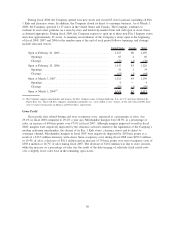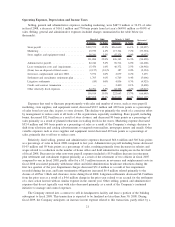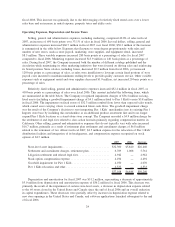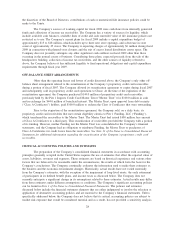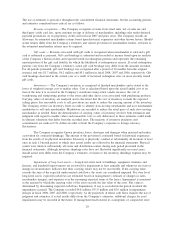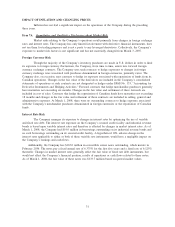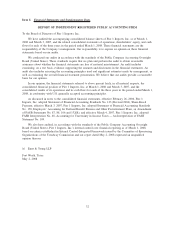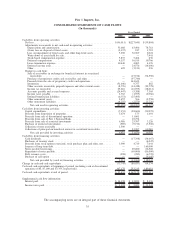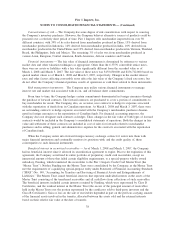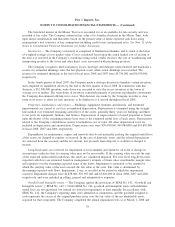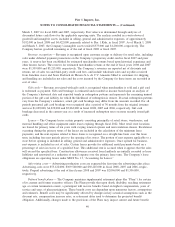Pier 1 2008 Annual Report Download - page 32
Download and view the complete annual report
Please find page 32 of the 2008 Pier 1 annual report below. You can navigate through the pages in the report by either clicking on the pages listed below, or by using the keyword search tool below to find specific information within the annual report.sales results by 3% over the next five years, additional impairment charges of approximately $3.8 million
would have been recorded in fiscal 2008.
Insurance provision — During fiscal 2008, the Company maintained insurance for workers’ compen-
sation and general liability claims with deductibles of $1,000,000 and $750,000, respectively, per claim. The
liability recorded for such claims is determined by estimating the total future claims cost for events that
occurred prior to the balance sheet date. The estimates consider historical claims development factors as well
as information obtained from and projections made by the Company’s insurance carrier and underwriters. The
recorded liabilities for workers’ compensation and general liability claims, including those occurring in prior
years but not yet settled, at March 1, 2008 were $19.0 million and $7.1 million, respectively.
The assumptions made in determining the above estimates are reviewed continually and the liability
adjusted accordingly as new facts are revealed. Changes in circumstances and conditions affecting the
assumptions used in determining the liabilities could cause actual results to differ from the Company’s
recorded amounts.
Defined benefit plans — The Company maintains supplemental retirement plans (the “Plans”) for
certain of its current and former executive officers. The Plans provide that upon death, disability, reaching
retirement age or certain termination events, a participant will receive benefits based on highest compensation,
years of service and years of plan participation. These benefit costs are dependent upon numerous factors,
assumptions and estimates. Benefit costs may be significantly affected by changes in key actuarial assumptions
such as the discount rate, compensation rates, or retirement dates used to determine the projected benefit
obligation. Additionally, changes made to the provisions of the Plans may impact current and future benefit
costs.
Stock-based compensation — The fair value of stock options is amortized as compensation expense
over the vesting periods of the options. The fair values for options granted by the Company are estimated as
of the date of grant using the Black-Scholes option-pricing model. Option valuation models require the input
of highly subjective assumptions, including the expected stock price volatility and the average life of options.
The Company uses expected volatilities and risk-free interest rates that correlate with the expected term of the
option when estimating an option’s fair value. To determine the expected term of the option, the Company
bases its estimates on historical exercise activity of grants with similar vesting periods. Expected volatility is
based on the historical volatility of the common stock of the Company for a period approximating the
expected life. The risk free interest rate utilized is the United States Treasury rate that most closely matches
the weighted average expected life at the time of the grant. The expected dividend yield is based on the annual
dividend rate at the time of grant or estimates of future anticipated dividend rates. If the Company had used
different assumptions, the value of stock options may have been different.
Income taxes — The Company records income tax expense using the liability method for taxes. The
Company is subject to income tax in many jurisdictions, including the United States, various states and
localities, and foreign countries. At any point in time, multiple tax years are subject to audit by various
jurisdictions and the Company records reserves for estimates of tax exposures for foreign and domestic tax
audits. The timing of these audits and negotiations with taxing authorities may affect the ultimate settlement
of these issues. The process of determining tax expense by jurisdiction involves the calculation of actual
current tax expense or benefit, together with the assessment of deferred tax expense resulting from differing
treatment of items for tax and financial accounting purposes. Deferred tax assets and liabilities are recorded in
the Company’s consolidated balance sheets and are classified as current or noncurrent based on the
classification of the related assets or liabilities for financial reporting purposes. A valuation allowance is
recorded to reduce the carrying amounts of deferred tax assets unless it is more likely than not those assets
will be realized. If different assumptions had been used, the Company’s tax expense or benefit, assets and
liabilities could have varied from recorded amounts. If actual results differ from estimated results or if the
Company adjusts these assumptions in the future, the Company may need to adjust its deferred tax assets or
liabilities, which could impact its effective tax rate. In evaluating the likelihood that sufficient earnings would
be available in the near future to realize the deferred tax assets, the Company considered cumulative losses
over three years including the current year.
30


